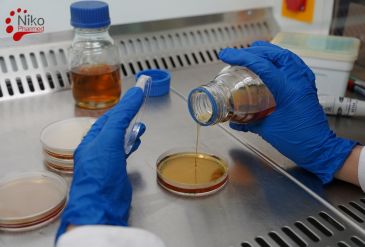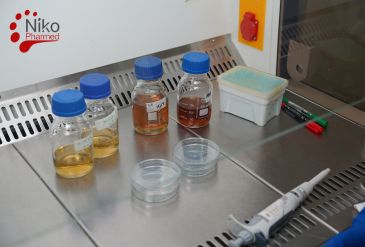What is Bacterial Endotoxin Testing?
Bacterial Endotoxin Testing (BET) is a compendial assay utilized for the detection and quantification of bacterial endotoxins—lipopolysaccharide (LPS) components of the outer membrane of Gram-negative bacteria. These endotoxins pose a significant risk when present in parenteral drugs and medical devices, potentially eliciting severe pyrogenic responses.
The bacterial endotoxin testing is based on the use of the Limulus Amebocyte Lysate (LAL) reagent, derived from the blood of the horseshoe crab (Limulus polyphemus), which contains a cascade of proteolytic enzymes that are specifically activated in the presence of endotoxins.
Bacterial Endotoxin Testing Procedure
According to the procedures described, the test can be performed using three methods: the Gel-Clot method, the Turbidimetric method, and the Chromogenic method. Each is scientifically valid and differs in sensitivity, quantification potential, and output.
1. Gel-Clot Method (Qualitative and Semi-Quantitative)
The Gel-Clot method is based on the clotting reaction of the LAL reagent in the presence of endotoxins. The endotoxin activates Factor C (a serine protease zymogen) in the LAL, initiating a cascade involving Factors B and C, which ultimately cleave coagulogen into coagulin, forming a visible gel clot.
Procedure
The test is performed by mixing equal volumes of the LAL reagent and the test solution or control.
Incubation occurs at 37 ± 1°C for 60 ± 2 minutes, undisturbed.
After incubation, the reaction tube is inverted 180°.
If a firm gel remains intact and does not collapse upon inversion, the result is considered positive.
Interpretation
The presence or absence of a gel clot is a binary result.
A dilution series may be used to determine the endpoint, allowing semi-quantitative assessment.
It is essential to include:
- Negative controls (LAL + endotoxin-free water),
- Positive product controls (PPC) to validate absence of inhibition or enhancement,
- Endotoxin standards at defined concentrations (e.g., 2λ, λ, 0.5λ, 0.25λ).
2. Turbidimetric Method (Quantitative)
The Turbidimetric method quantifies endotoxin based on the increase in turbidity caused by the coagulin polymerization reaction. As the LAL cascade progresses in the presence of endotoxin, the mixture becomes increasingly opaque due to clot formation. This change in turbidity is measured photometrically over time.
Subtypes
Kinetic Turbidimetric Assay: Measures the time taken to reach a predetermined optical density (OD) threshold.
Endpoint Turbidimetric Assay: Measures OD at a fixed time point after incubation.
Procedure
LAL reagent and test sample (or standards) are incubated at 37 ± 1°C in a microplate or tube.
Turbidity (typically at 340 nm or 405 nm) is measured using a spectrophotometer or kinetic microplate reader.
Reaction time is inversely proportional to the endotoxin concentration (in kinetic format).
Quantification
A standard curve is generated using known concentrations of endotoxin standards.
Test sample concentrations are calculated by comparing their OD values or reaction times against the curve.
Results are expressed in Endotoxin Units per milliliter (EU/mL).
Chromogenic Method (Quantitative)
The Chromogenic method uses a synthetic peptide substrate coupled to a chromophore, typically p-nitroaniline (pNA). Upon endotoxin activation of the LAL cascade (via Factor C), an activated clotting enzyme cleaves the substrate, releasing pNA. The intensity of the yellow color developed is directly proportional to the endotoxin concentration and can be measured spectrophotometrically.
Subtypes
Kinetic Chromogenic Assay: Measures the rate of color formation over time.
Endpoint Chromogenic Assay: Measures absorbance at a fixed time point, typically at 405 nm.
Procedure
The test solution or standard is mixed with LAL reagent and chromogenic substrate.
Incubation occurs at 37 ± 1°C.
Absorbance is monitored at 405 nm using a microplate reader or spectrophotometer.
In kinetic format, time to reach a defined absorbance is used for quantification; in endpoint format, final absorbance is used.
Quantification
A calibration curve is prepared using standard endotoxin concentrations.
Test sample concentrations are interpolated from the curve.
Results are reported in EU/mL.
Common Requirements Across All Methods:
Validation of the test system: An inhibition/enhancement test must be conducted to confirm that the sample matrix does not interfere with the assay. This involves spiking the test article with a known endotoxin concentration and demonstrating accurate recovery (50–200%).
Reagents and Equipment: Only endotoxin-free consumables, depyrogenated glassware, and certified Water for BET (water for injection free from endotoxins) must be used.
Endotoxin Limit: The maximum allowable endotoxin concentration is determined by the product’s dose and route of administration, using the formula:
Endotoxin limit (EU/mL)=KM\text{Endotoxin limit (EU/mL)} = \frac{K}{M}
Where:
- K = threshold pyrogenic dose of endotoxin (EU/kg),
- M = maximum human dose per kilogram of body weight per hour.
Maximum Valid Dilution (MVD): The greatest dilution of a sample that does not exceed the endotoxin limit, calculated to ensure sensitivity and minimize interference.
Here is a detailed comparison of the three Bacterial Endotoxin Test (BET) methods in tabular form:
| Parameter | Gel-Clot Method | Turbidimetric Method | Chromogenic Method |
|---|---|---|---|
| Principle | Endotoxins activate LAL cascade causing gel formation | Endotoxins increase turbidity via clotting cascade | Endotoxins trigger color release via chromogenic substrate |
| Output Type | Qualitative / Semi-Quantitative | Quantitative | Quantitative |
| Detection Endpoint | Presence or absence of a firm gel clot | Increase in optical density (turbidity) | Release of p-nitroaniline (color intensity) |
| Measurement Method | Visual inspection | Spectrophotometry at 340 or 405 nm | Spectrophotometry at 405 nm |
| Assay Formats | Endpoint only | Kinetic or Endpoint | Kinetic or Endpoint |
| Sensitivity Range | Typically 0.03–1.0 EU/mL | Down to 0.001 EU/mL (kinetic); method-dependent | Down to 0.001 EU/mL (kinetic); method-dependent |
| Quantitative Capability | No (only semi-quantitative via dilution series) | Yes | Yes |
| Ease of Use | Simple to perform; no equipment needed | Requires spectrophotometer or kinetic reader | Requires spectrophotometer or kinetic reader |
| Time to Results | ~1 hour | ~1–2 hours (depending on kinetic reaction) | ~1–2 hours (depending on kinetic reaction) |
| Result Interpretation | Subjective (visual clot formation) | Objective (measured OD or time to threshold) | Objective (measured absorbance) |
| Suitability for Automation | Low | High | High |
| Reagent Cost | Lower | Moderate | Higher (due to chromogenic substrate) |
| Common Use Cases | Routine batch release, low throughput settings | High-throughput or automated systems | High sensitivity, quantitative accuracy required |
| Interference Sensitivity | Less sensitive to optical interference | Sensitive to turbid or colored samples | Sensitive to colored samples |
| Standard Curve Requirement | Not required (pass/fail method) | Required | Required |
| Validation Requirement | Inhibition/Enhancement test with positive product control | Same as Gel-Clot | Same as Gel-Clo |
All three BET methods—Gel-Clot, Turbidimetric, and Chromogenic—are scientifically robust and rely on the activation of the LAL protease cascade in the presence of endotoxins. The method selection depends on the required sensitivity, instrumentation availability, and nature of the test sample. Each method must be carefully validated and controlled to ensure compliance with pharmacopeial standards and patient safety.
Why Choose Nikopharmad for Your Bacterial Endotoxin Testing (BET) Needs?
ILAC Accreditation & ISO/IEC 17025 Certification
Nikopharmad Laboratory operates under the stringent quality and technical competence standards defined by ISO/IEC 17025 and is fully accredited under the ILAC mutual recognition arrangement.
This accreditation assures that our Bacterial Endotoxin Testing results are globally recognized and accepted by regulatory agencies such as the FDA, EMA, PMDA, and TÜV—streamlining international regulatory submissions, batch release processes, and market approvals.
Comprehensive Endotoxin Detection Methods
We offer a full suite of validated BET services, including Gel-Clot, Kinetic Turbidimetric, and Kinetic Chromogenic assays. All methods are performed in strict accordance with compendial standards such as USP <85>, EP 2.6.14, and JP guidelines.
Our Bacterial Endotoxin Testing protocols are designed to accurately detect and quantify endotoxins across a broad range of sample types—including final drug products, in-process materials, raw ingredients, and water for injection (WFI)—while effectively managing product-specific interferences through validated inhibition/enhancement testing. Also establishing appropriate alert and action limits for in-process bioburden testing helps ensure that endotoxin levels remain under control long before final BET is performed.
Expert Scientific Team & Cutting-Edge Laboratory Infrastructure
Nikopharmad’s BET program is led by an experienced team of microbiologists, biochemists, and quality professionals with deep expertise in pyrogen testing and microbiological quality control.
Our laboratory is equipped with state-of-the-art endotoxin testing platforms, including FDA-licensed LAL reagents, depyrogenated glassware, automated endotoxin readers, and endotoxin-free water systems. Each test is performed in a controlled, contamination-free environment to ensure maximum accuracy and sensitivity, typically detecting as low as 0.005 EU/mL.
Fast Turnaround Time with Fully Validated Protocols
In time-critical pharmaceutical development and manufacturing environments, speed and reliability are paramount. Our laboratory offers optimized workflows for rapid endotoxin testing, supporting both routine batch release and expedited product release timelines. All methods are rigorously validated in compliance with regulatory requirements, delivering high-precision, reproducible results with minimal retesting or delays.
Data Security & Intellectual Property Protection
Client confidentiality is a cornerstone of our operation. We enforce strict data security protocols, non-disclosure agreements (NDAs), and robust electronic data management systems to ensure that your formulations, results, and regulatory files are fully protected. Our audit-ready documentation supports full traceability and regulatory transparency at every stage of the testing lifecycle.
Regulatory Compliance & Global Submission Readiness
Our BET reports are formatted to meet global regulatory expectations, with clear data presentation and method validation summaries in accordance with USP <85>, EP 2.6.14, JP, and ICH Q6B guidelines. Whether you are preparing regulatory submissions for the FDA, EMA, NMPA, or other health authorities, our services ensure your biologics, injectables, and advanced therapy products meet the strictest international pyrogen safety requirements.
To request testing or a complimentary consultation contact Nikopharmad
By selecting Nikopharmad for your Bacterial Endotoxin Testing, you gain a trusted, globally recognized laboratory partner with proven expertise in microbiological safety and regulatory compliance. Our precision testing, rapid turnaround, and unwavering commitment to data integrity ensure your products are safe, compliant, and ready for market.
Why is Bacterial Endotoxin Testing important?
The importance of bacterial endotoxin testing stems from the severe biological effects of endotoxins—lipopolysaccharide components of the outer membrane of Gram-negative bacteria—which, even in minute quantities, can induce pyrogenic responses such as fever, inflammation, hypotension, and in extreme cases, septic shock or death when introduced into the bloodstream or cerebrospinal fluid.
According to the guidelines outlined in USP <85>, BET provides a validated and standardized methodology for the detection and quantification of these endotoxins using the Limulus Amebocyte Lysate (LAL) reagent. The compendial method recognizes three main assay types—gel-clot, turbidimetric, and chromogenic—all of which are based on the specific activation of the LAL enzymatic cascade by endotoxins.
Furthermore, regulatory authorities such as the FDA, EMA, and WHO recognize BET as a key release criterion. It is often a focal point in Good Manufacturing Practice (GMP) inspections and product licensure. The ability to accurately detect endotoxins—while accounting for potential interference from product matrices through proper validation steps such as the inhibition/enhancement test—is a demonstration of analytical robustness and scientific rigor.


